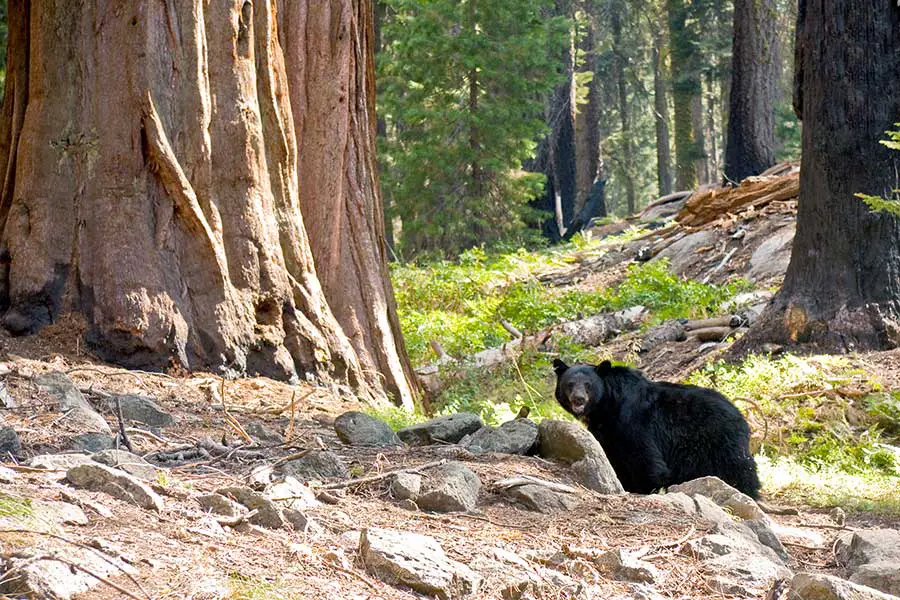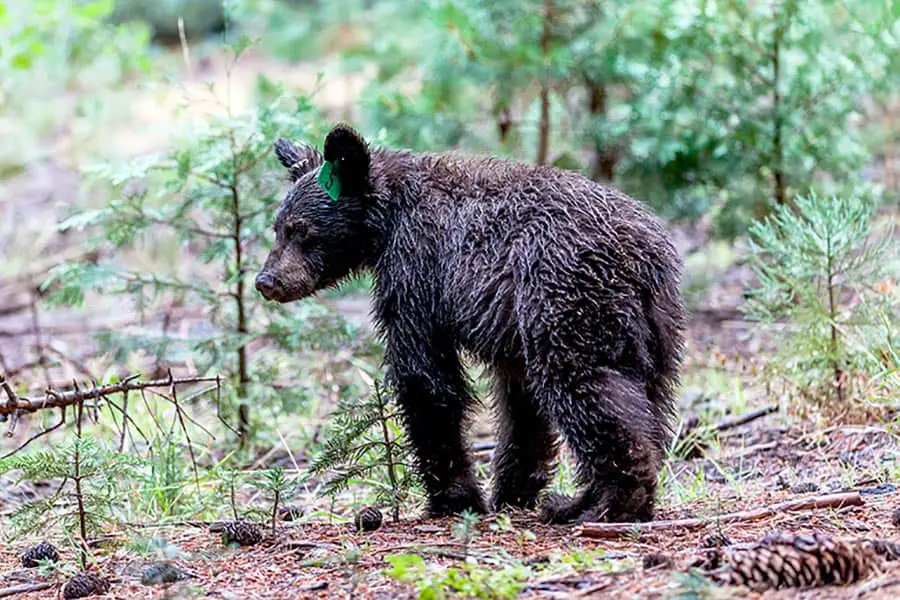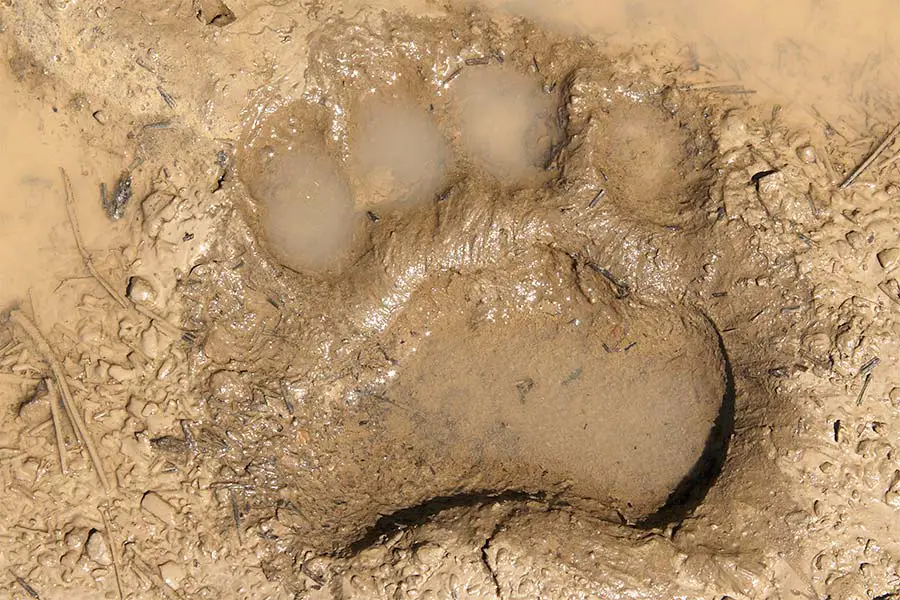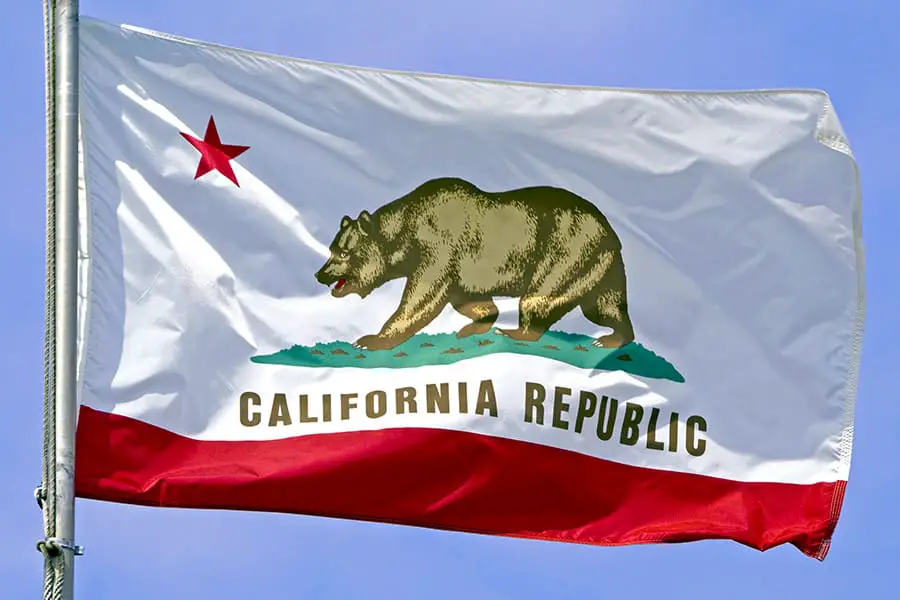
For visitors looking to explore the great outdoors, California is one of the top places in the country to visit. The Golden State is home to nine impressive national parks and dozens of state parks, which give stunning views and the chance to spot incredible wildlife, including some predators at the top of the food chain. But, you might be wondering, is California home to bears?
California is home to a large population of black bears, with counts estimated to be in the range of 30,000 to 40,000. In general, you can find bears in mountainous or wooded regions of the state, including parks around the San Francisco Bay Area and Los Angeles.
While bear encounters are relatively uncommon, you should become familiar with the behaviors that can attract bears. As you continue reading, you will learn more about these amazing creatures and how to keep you and your group safe when visiting California’s natural spaces.
Bears – Will You Find Them in California?
The official flag of California features a bear, so it should come as no surprise that many bears live in the state. Because of its ideal climate and landscape, California is home to a large population of black bears. Most of these bears live in the northern part of the state, especially in mountainous areas like the Sierra Nevada Mountains.
Despite the grizzly bear being featured on the state’s flag, black bears are the only species found in California today. But, don’t let the name fool you. Even though they are called “black” bears, they actually come in a variety of shades ranging from light brown to black.
These bears can be broken down into two main subspecies — the California black bear and Northwestern black bear. These two types of black bears are nearly identical, with their main difference being their geographic location within the state.
Black bears typically grow to be four to seven feet in length and stand three feet tall from the ground to their shoulders. Male black bears are considerably larger than females. Females weigh up to 180 lbs. while males can exceed 600 lbs.
Black bears prefer to live in mountainous, wooded areas with thick undergrowth and vegetation. Much of their natural habitat can be found on land administered by the US Forest Service, which helps protect them and reduce the number of encounters with humans.
The diet of a black bear is highly diverse. Considered omnivores, black bears will eat just about anything, including grass, roots, berries, fish, insects, succulent plants, and larvae. Unfortunately, black bears can easily acquire a taste for human foods, which presents a challenge for park rangers as mishandled food can attract bears into picnic areas and campsites.
Bay Area Answers Fun Fact: Bears are persistent when it comes to finding food and have been known to rip doors off vehicles to get to the goodies inside.
Where do Bears Live in California?
Bears live in many parts of the state. According to the California Department of Fish and Wildlife, over 40 percent of the bear population resides in the Sierra Nevada Mountains.
You don’t have to be worried about bears if you plan to visit a major metropolitan area like San Francisco; however, there is a chance of encountering bears in natural spaces in the nearby Marin and Sonoma counties. Bears are less common in Southern California, but national forests near Los Angeles do have a population of a few hundred bears.

Are Bears Protected in California?
Black bears do not currently have a protected status in the State of California. Each year, the Department of Game and Fish issues about 30,000 bear hunting permits. However, to ensure that bears are not overhunted, the state has a harvest limit of 1,700 bears each year. Once the limit is reached, the bear hunting season closes. However, the total number of bears harvested varies from year to year because, in some years, the 1,700 allowable harvest quota doesn’t get reached.
Being able to hunt bears may change in the future. A California state senator introduced a bill that would ban hunting to protect black bear populations, though as of yet, it hasn’t happened.
A survey in 1982 found that the bear population had dipped as low as 10,000 to 15,000 bears. Despite the fact that bear populations have been increasing over the last 25 years, there is concern that the loss of habitat from recent years of record-breaking wildfires could threaten the species.
Aside from humans, black bears don’t have many natural predators. However, bears have a naturally slow reproduction rate. During hibernation, a female bear’s body will reabsorb her eggs if she is malnourished, making her unable to produce a cub. If their habitat is destroyed, bears could quickly lose access to food and ultimately slow their birth rates.
Other Posts of Interest
- Can You Drive To The Top Of Mt. Diablo?
- Is Point Reyes National Seashore Worth Visiting?
- Does San Francisco Have Seals Or Sea Lions?
- Is It More Expensive To Live In San Francisco Or Los Angeles?
Are California Bears Dangerous?
Black bears are powerful creatures that can cause harm to humans if they are provoked. However, black bears are typically not aggressive creatures and tend to steer clear of humans.
As populations in California have risen over the years and with more visitors to state and national parks, black bear encounters have become more common. The Department of Fish and Wildlife keeps a record of all bear incidents. There have been zero fatalities from bears since 1986.

How to Stay Safe from Bears When Hiking or Camping
Most attacks are the result of a bear feeling threatened, especially when they are with their young cubs. Many of the attacks are from people getting too close wanting to take a look (or worse, a selfie). Fortunately, there are some ideas that you can put into practice to help avoid bear encounters and attacks.
- Make Some Noise – If a bear hears you coming, they will likely move out of the area to avoid you. Therefore, talking loudly with your hiking companions is beneficial. You can also purchase a bear bell that hangs from your hiking pack and jingles as you walk.
- Store Food Properly – Bears like to scavenge for food and have an incredible sense of smell. Therefore, keep food locked up in your vehicle. Many parks and picnic areas have special “bear boxes” where you can store food safely. During meal or snack time, clean up any food waste or trash as this can attract bears.
- Look for Signs of Bears – When you are out hiking, keep an eye out for signs that a bear could be present such as tracks, bear droppings, trees missing large patches of bark (bears like to strip and eat the bark), or fresh animal carcasses. If you come across any of these signs, remain alert as there could be a bear present.
- Protect Your Pets – Keep your pets on a leash at all times. The last thing you need is for Rover to dart into the woods after a bear. Also, treat pet food and treats the same way as human food as this can attract a bear looking for a snack.
Note: Bear spray can be a good defense against an aggressive bear. However, check with the local park ranger to see if bear spray is allowed or even necessary. For example, parks like Yosemite National Park don’t permit bear spray. Also, since black bears are significantly less aggressive than other bear species, carrying bear spray might not be necessary.
There are estimated to be 750,000 black bears in all of North America, and they kill less than one person on average each year.

Why is There a Bear on the California Flag?
The first version of the California flag was flown during the Bear Flag Revolt of 1846, when California gained independence from Mexico. At the time, California was home to a population of grizzly bears. These creatures became a symbol of the power of the California Republic.
The bear seen on the flag that we have today was inspired by Monarch, the last remaining California Grizzly held in captivity until she died in 1911. In the same year as her death, California adopted the bear flag as the official state flag.
What Happened to the California Grizzly Bear?
Unfortunately, the California grizzly bear was driven to extinction about a hundred years ago. Scientists believe that as many as 10,000 of these massive creatures once roamed in most parts of the state. Their demise came with the increase of the human population in the state.
As more people moved to California, people feared the chance of being attacked. As a result, most of the population was eliminated in the decades following the California Gold Rush. There are conflicting stories around the last remaining grizzly bear, but generally, the last was believed to be a bear killed by a road crew in Tulare County in 1922 (although no official evidence was ever produced).
There have been proposals to introduce other species of grizzly bears to California to attempt to revive the large bear population, but this has not gained traction.
Stay Bear-Safe
The wild areas of California offer many opportunities to see bears but remember they are not the cute, cuddly stuffed ones from your childhood. It is exciting if you do happen to get the chance to observe these incredible creatures in their natural habitat, but remember, it is best done from a safe distance.
When visiting a state or national park, remember to follow all bear safety rules, keep food properly stored, don’t feed the bears, ask a park ranger about any recent bear sightings, and for any tips they may have to keep you and your family safe.





